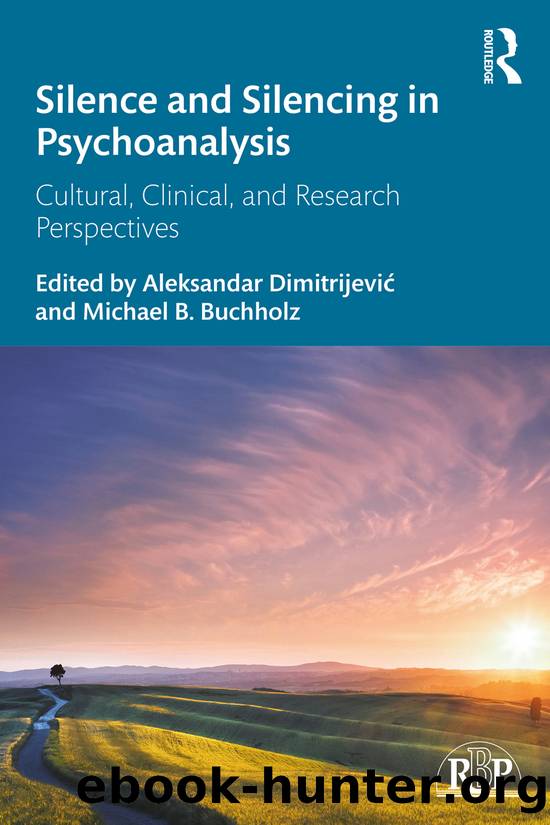Silence and Silencing in Psychoanalysis by Aleksandar Dimitrijević

Author:Aleksandar Dimitrijević
Language: eng
Format: epub
ISBN: 9781000217612
Publisher: Taylor and Francis
Published: 2020-09-17T00:00:00+00:00
The importance of silence for the individual patient
Relatively ignored by Freud in favour of the later stage of the Oedipus complex, the babyâs earliest developmental period journeys from late pregnancy, through the individualâs birth into what for Freud was âautoeroticismâ and âprimary narcissismâ and then on to the establishment of a rudimentary boundary (the first recognition of the âmeâ/ânot meâ distinction) in the context of the first object choice within the environment of the nursing couple; the babyâs absolute and then relative dependence on the motherâs care. Freudâs relative inattention to this earliest developmental time is recognized by Goldman (1993) when he suggests that Winnicott made it his lifeâs work to elaborate what Freud put in a footnote.
Winnicott does indeed bring to life this important pre-Oedipal stage that is âpreverbal, unverbalized and unverbalizableâ (1967, p. 112) and a silence interspersed with sounds; he emphasizes all that happens outside language and before words. Winnicott includes early behaviour and the rich variety in the quality of silences that occurs within the nursing couple. His oeuvre is a passionately observed exposition of the development of the unique human subject in the early environment of the âordinary devotedâ mother and her habits of baby care. In parallel Winnicott explored the traces of this earliest time of life and its vagaries as they manifest between the analytic couple, the therapist and patient, in the clinical psychoanalytic encounter.
Although eventually a fully-fledged human being, what Winnicott saw as the newly born âbundle of anatomy and physiologyâ can only be considered a psychical entity as an infantâmother unit and when one includes along with the baby, the care of the âordinary devotedâ mother; Freudâs aforementioned footnote (Freud, 1911, p. 220). In detailing the prehistory and early history of the human being and in exploring its lessons for psychoanalytic technique, Winnicott believes that as a Freudian, he is simply taking up where Freud left off.
In his early days as a pediatrician, as shown in his first book Clinical Notes on Disorders of Childhood, Winnicott (1931) wished to inform his medical colleagues of how, by history-taking and observation of the childâs clinical presentation, one can differentially diagnose the emotional disorder which speaks silently through bodily symptoms from ordinary organic disease.
Winnicott shows that so much is happening between the baby and the mother at the beginning. The good enough mother by her perfect adaptation to the babyâs needs creates a situation for her baby, an illusion of unity, which allows the baby the experience of omnipotence and to simply âbeâ in demand-free relaxed identification with their mother. From their own perspective, the absolutely but obliviously dependent baby âisâ the mother and the mother âisâ the baby. Through this reliable care experienced over time, the baby builds a confidence that what they need they will create/find (with creating and finding being paradoxically considered identical). In unconscious fantasy, the baby also âdestroysâ the mother who repeatedly survives the greedy primitive loving of feeding.
Over time there is important growth which is met by a
Download
This site does not store any files on its server. We only index and link to content provided by other sites. Please contact the content providers to delete copyright contents if any and email us, we'll remove relevant links or contents immediately.
| Administration & Medicine Economics | Allied Health Professions |
| Basic Sciences | Dentistry |
| History | Medical Informatics |
| Medicine | Nursing |
| Pharmacology | Psychology |
| Research | Veterinary Medicine |
Bioenergetica by Alexander Lowen(1124)
Noise: A Flaw in Human Judgment by Sunstein Cass R. & Sibony Olivier & Kahneman Daniel(968)
The Data Detective by Tim Harford(946)
The Child in You by Stefanie Stahl(883)
Chatter by Ethan Kross(799)
The Science of Rapid Skill Acquisition by Peter Hollins(639)
Freedom by Sebastian Junger(633)
No Bad Parts by Richard C. Schwartz(605)
The Montessori Baby by Simone Davies(566)
Evolution Gone Wrong: The Curious Reasons Why Our Bodies Work by Alex Bezzerides(560)
The Quantum Psychiatrist: From Zero to Zen Using Evidence-Based Solutions Beyond Medication and Therapy by Biswas Dona(551)
Maps of Meaning: The Architecture of Belief by Jordan B. Peterson(551)
The Science of Self-Learning: How to Teach Yourself Anything, Learn More in Less Time, and Direct Your Own Education (Learning how to Learn Book 1) by Peter Hollins(522)
Anxiety For Dummies by Charles H. Elliott & Laura L. Smith(512)
Sadomasochism and the BDSM Community in the United States by Stephen K. Stein(498)
Disconnected by thomas Kersting(482)
Why Sex Doesn't Matter by Olivia Fane(481)
The Mechanics of Passions: Brain, Behaviour, and Society by Alain Ehrenberg(480)
Jung - The Key Ideas: Teach Yourself (TY Philosophy) by Ruth Snowden(468)
